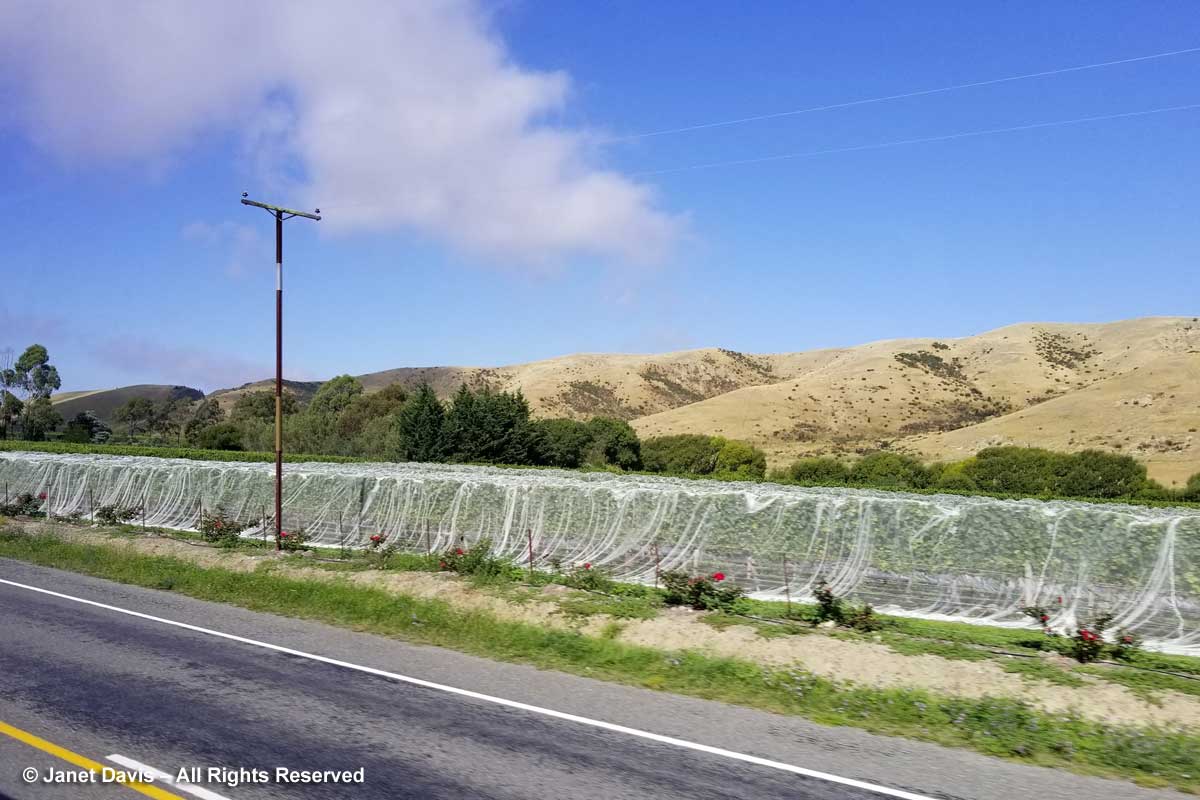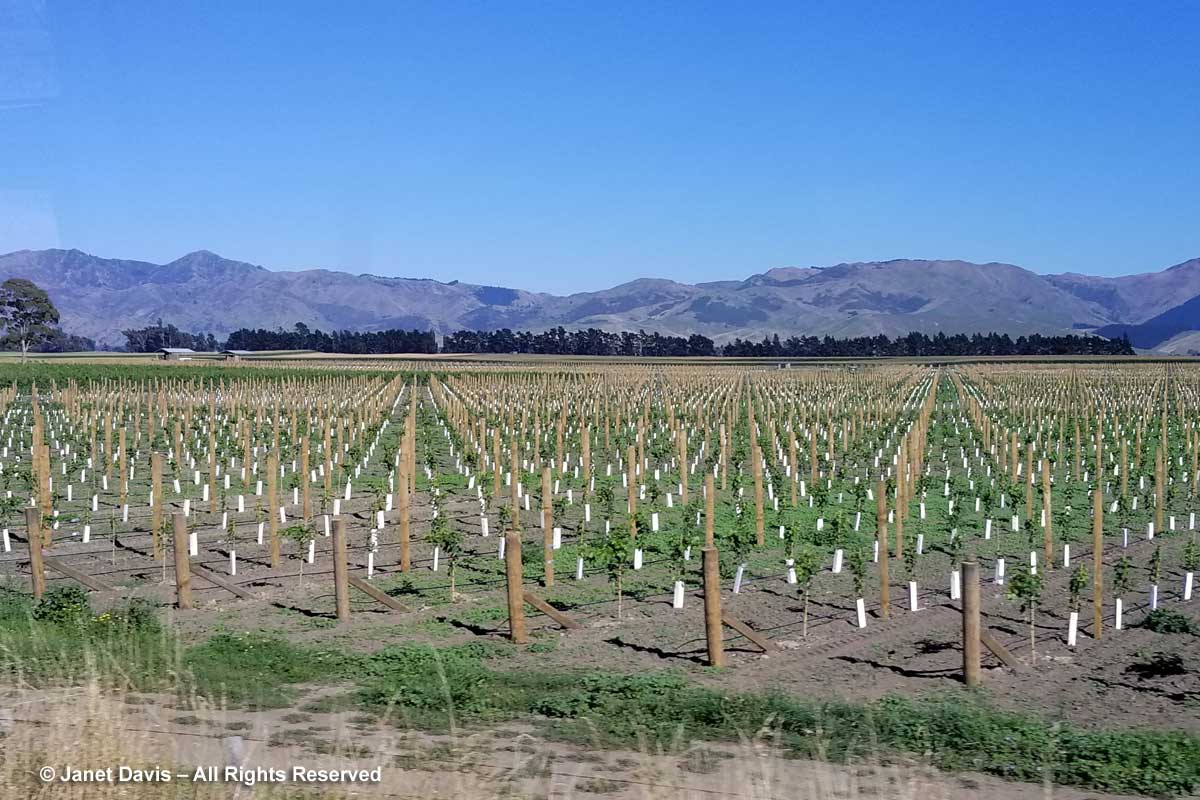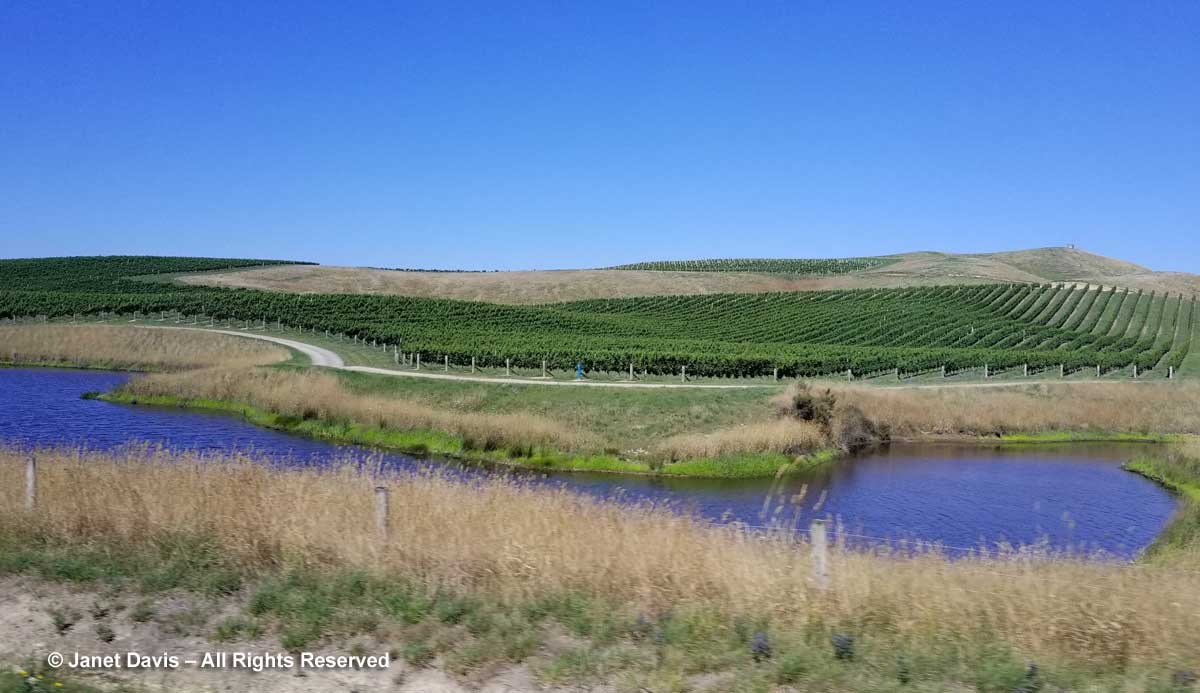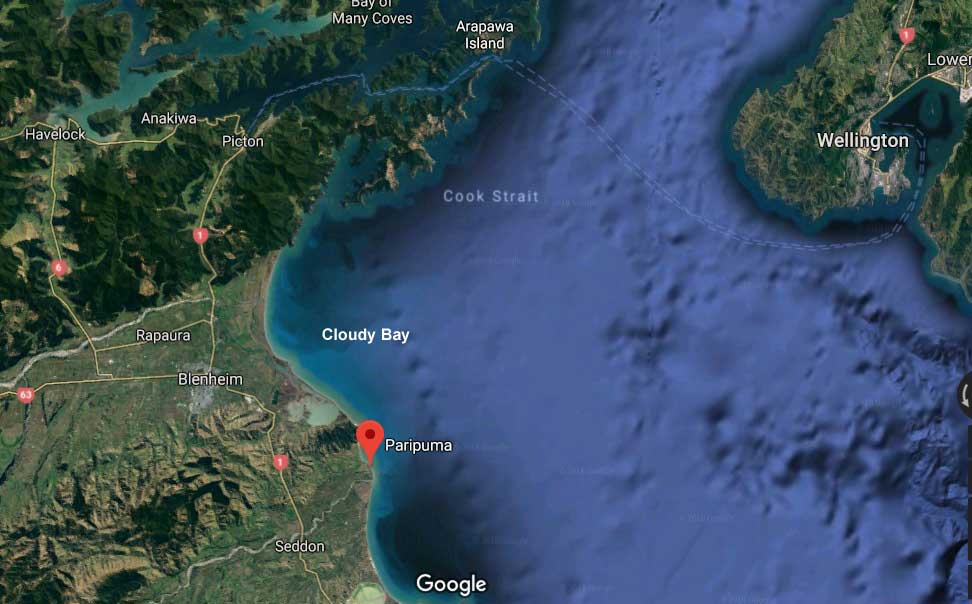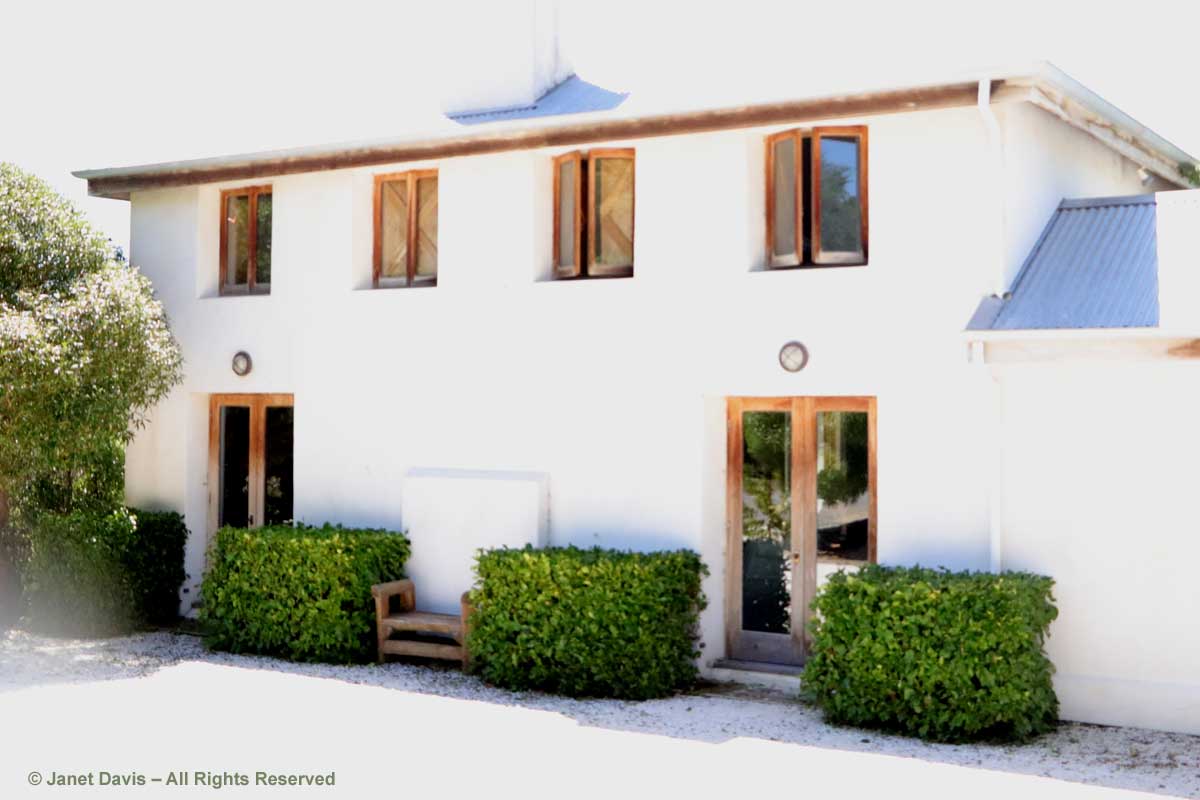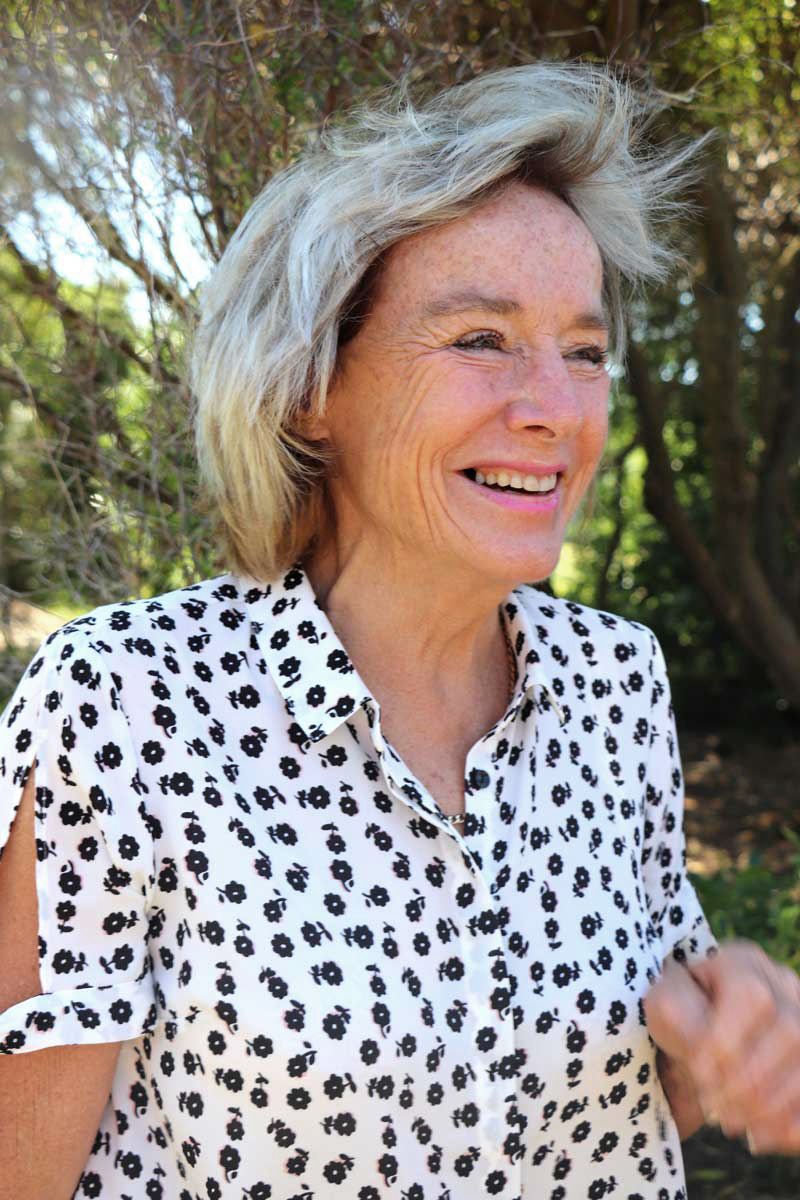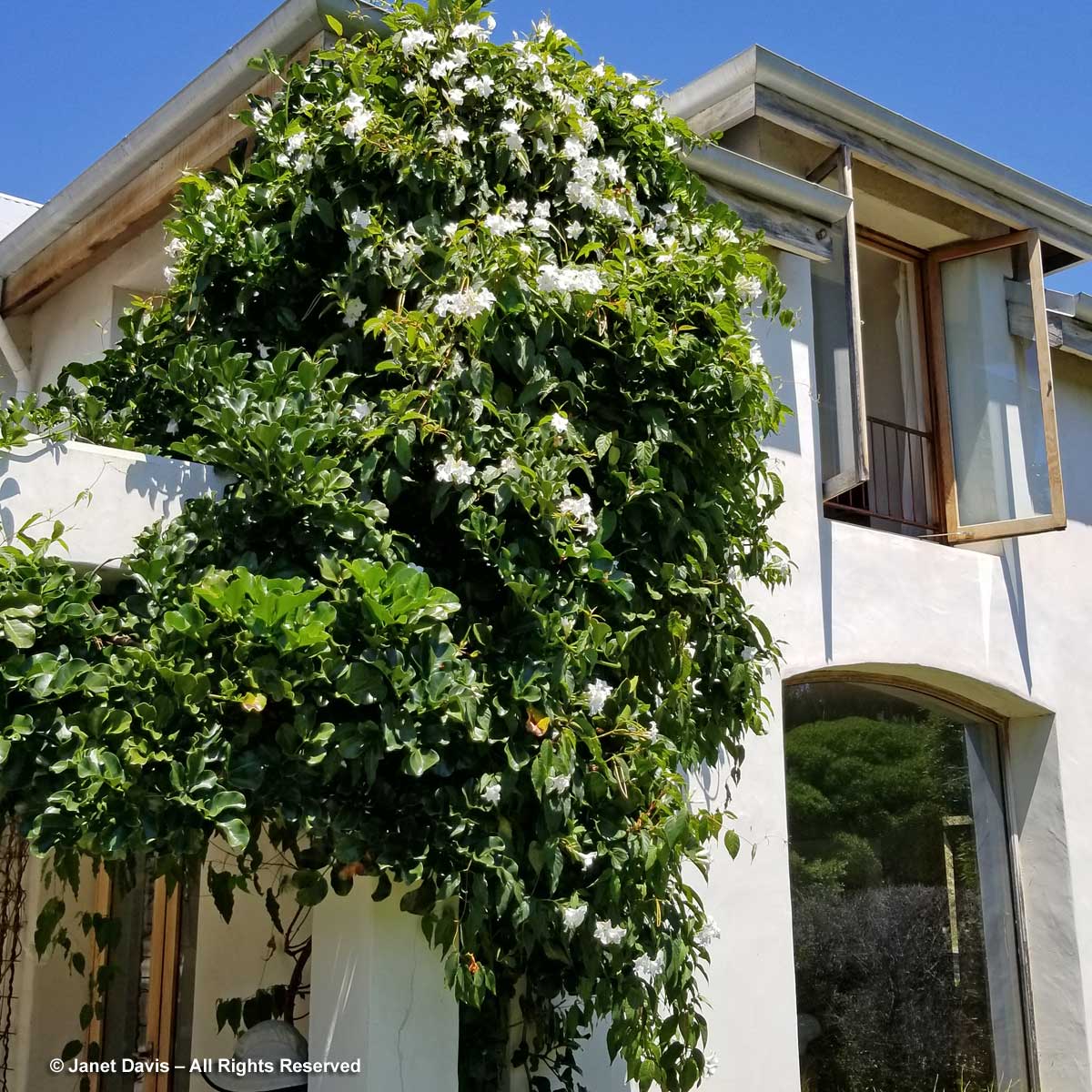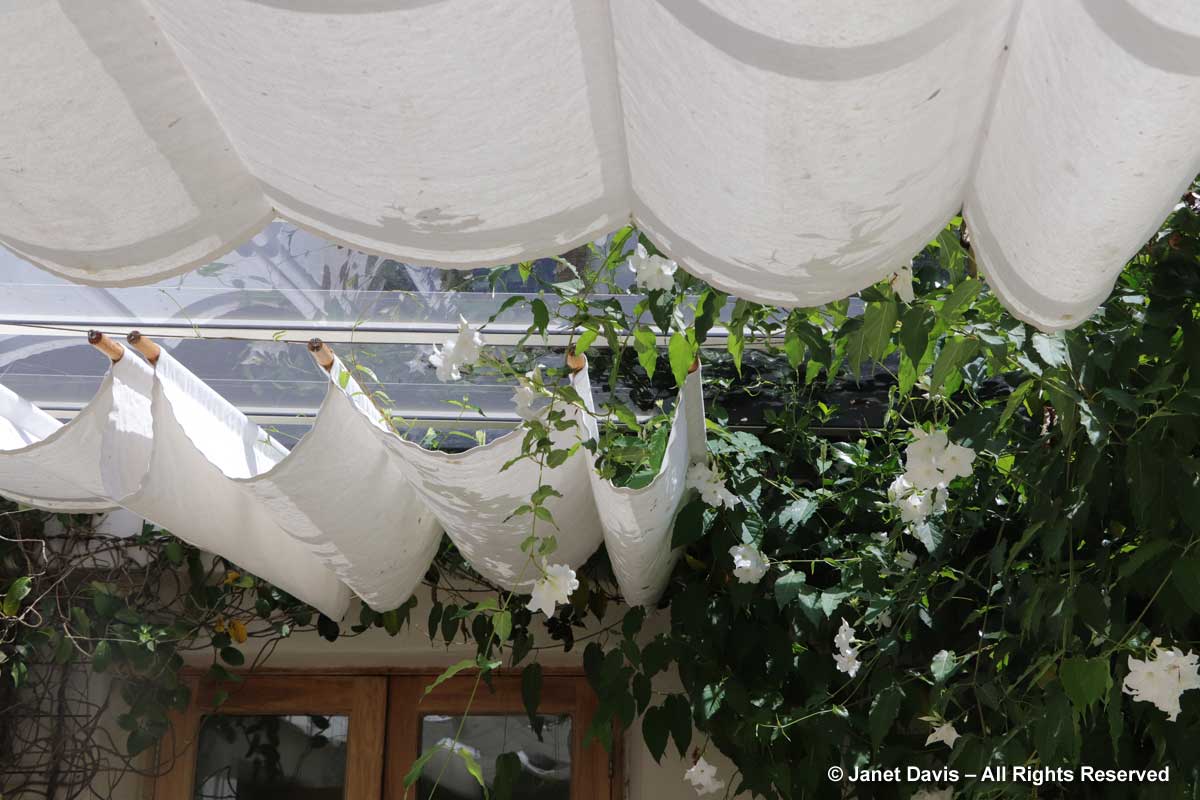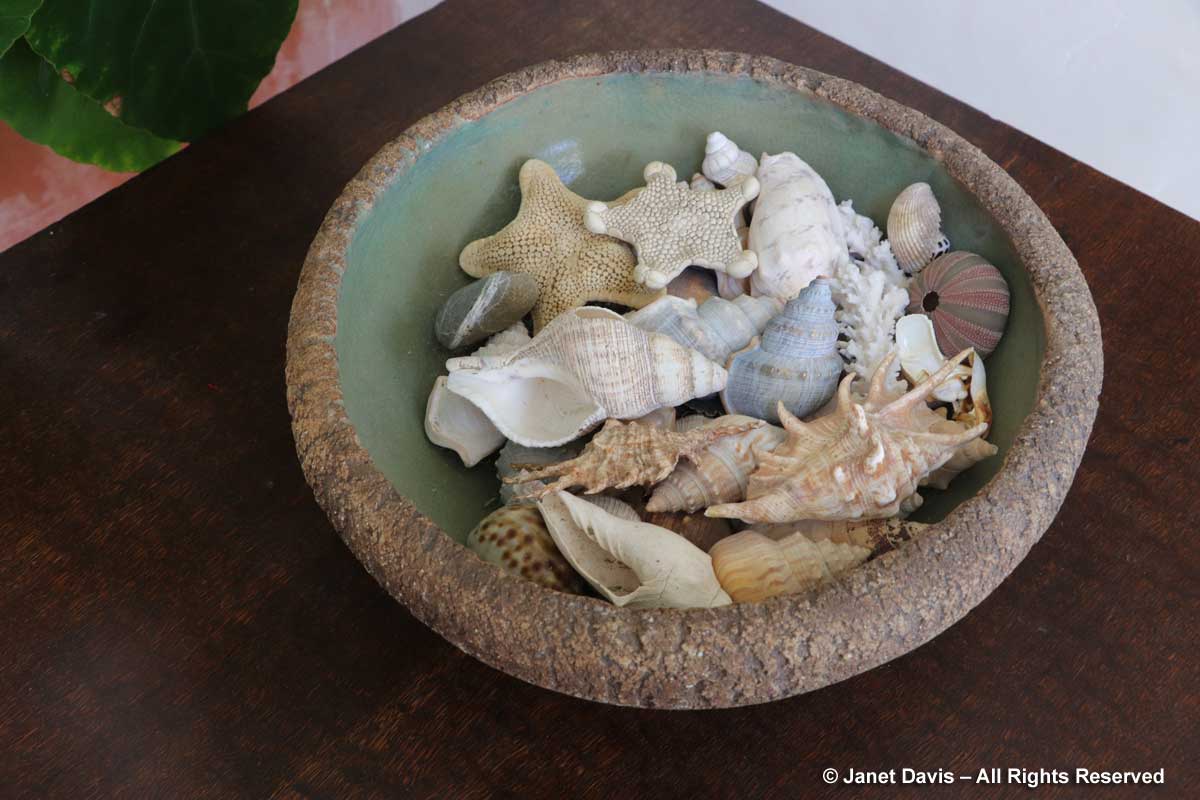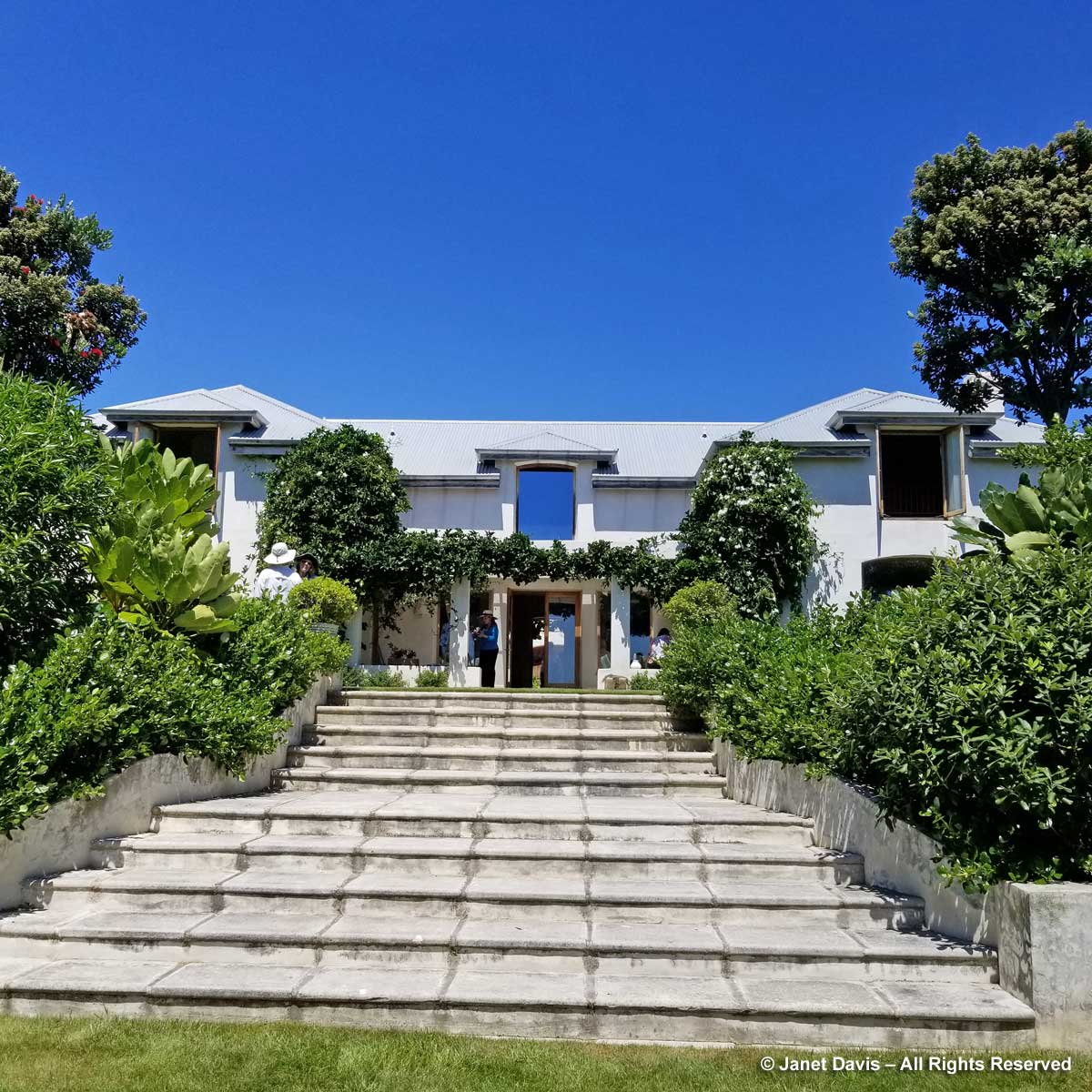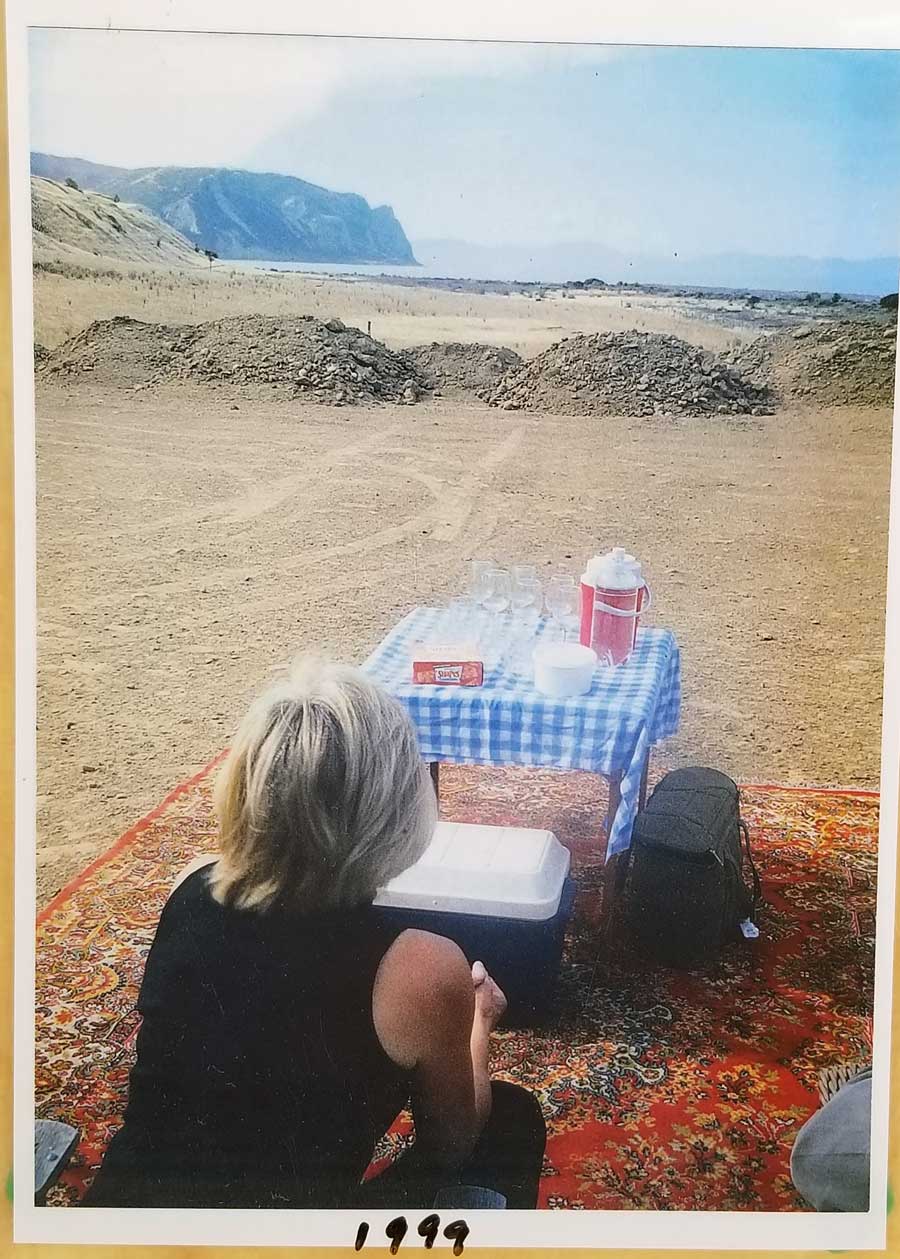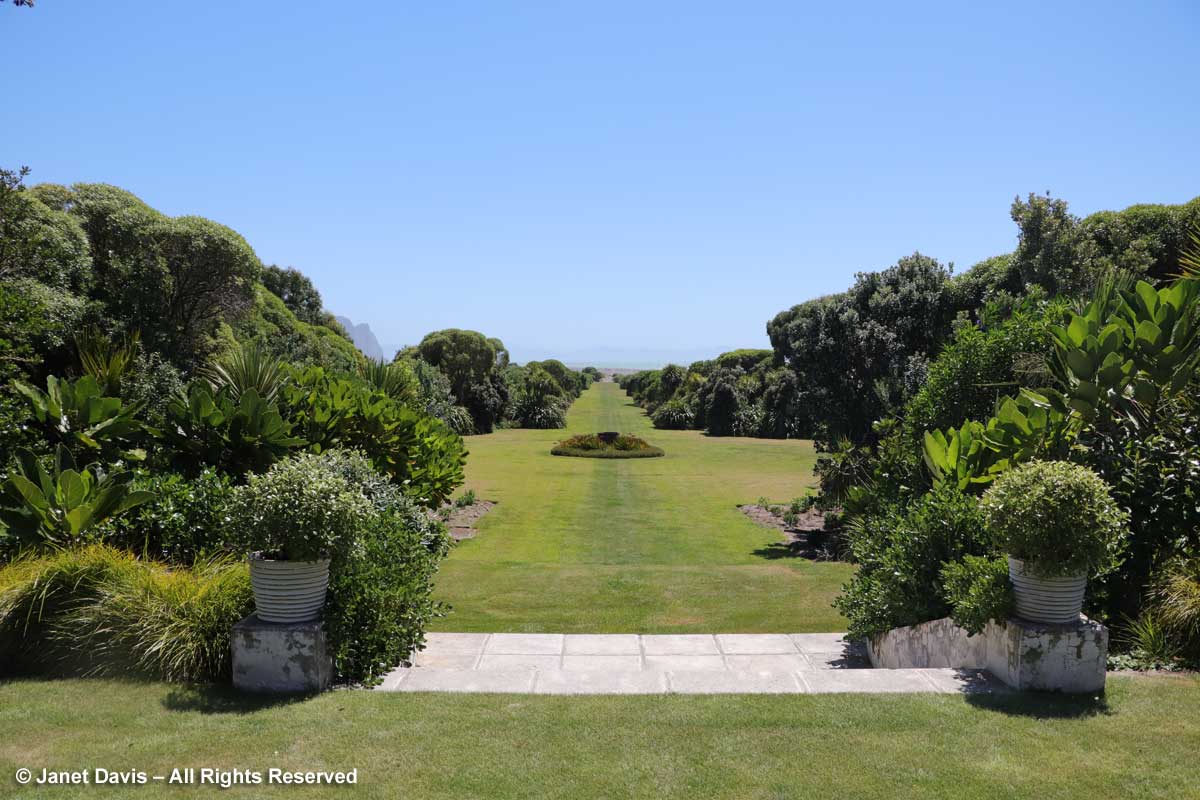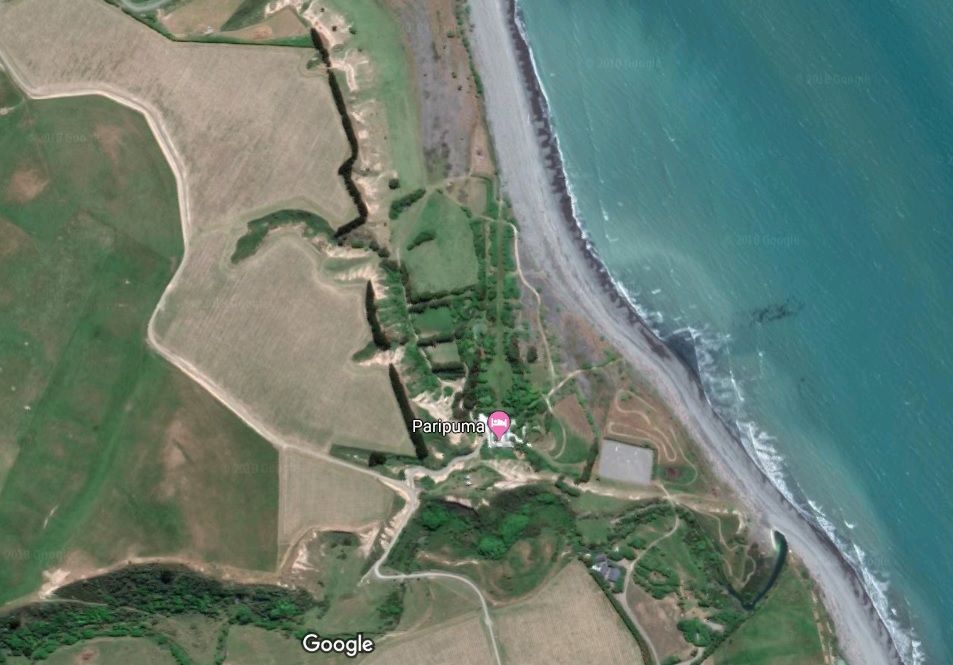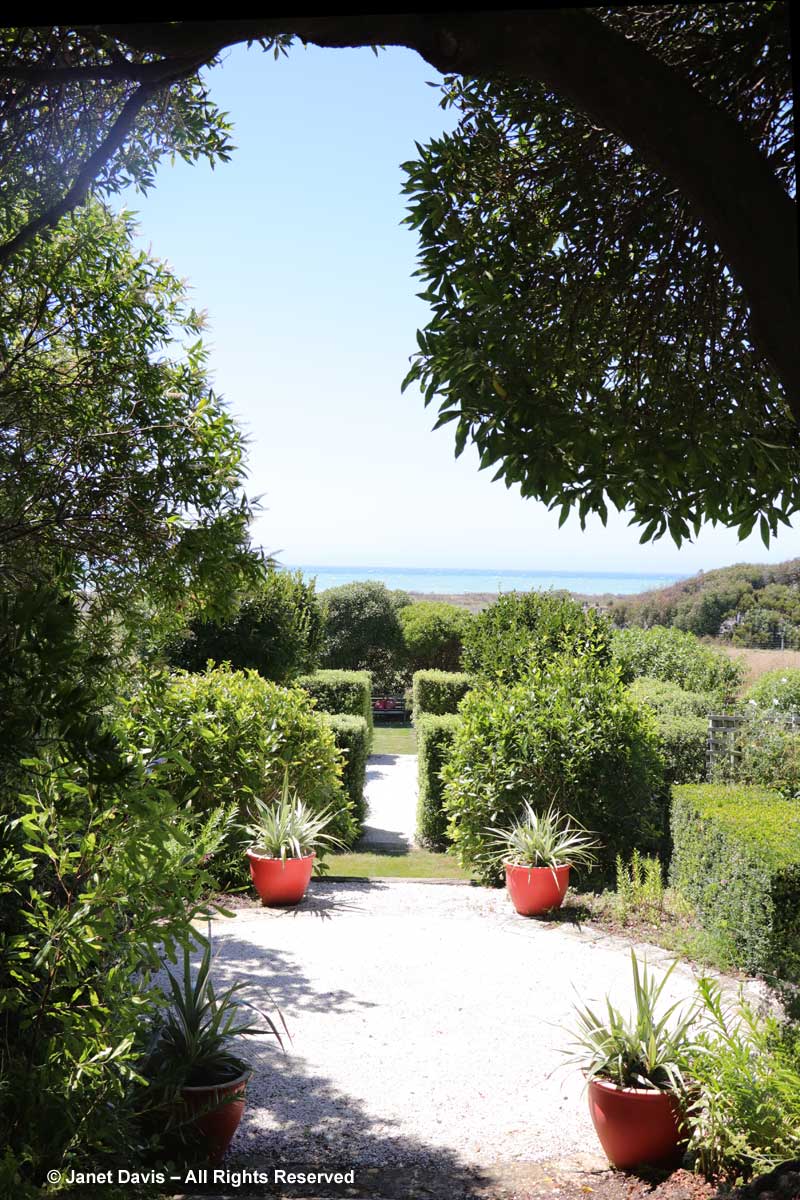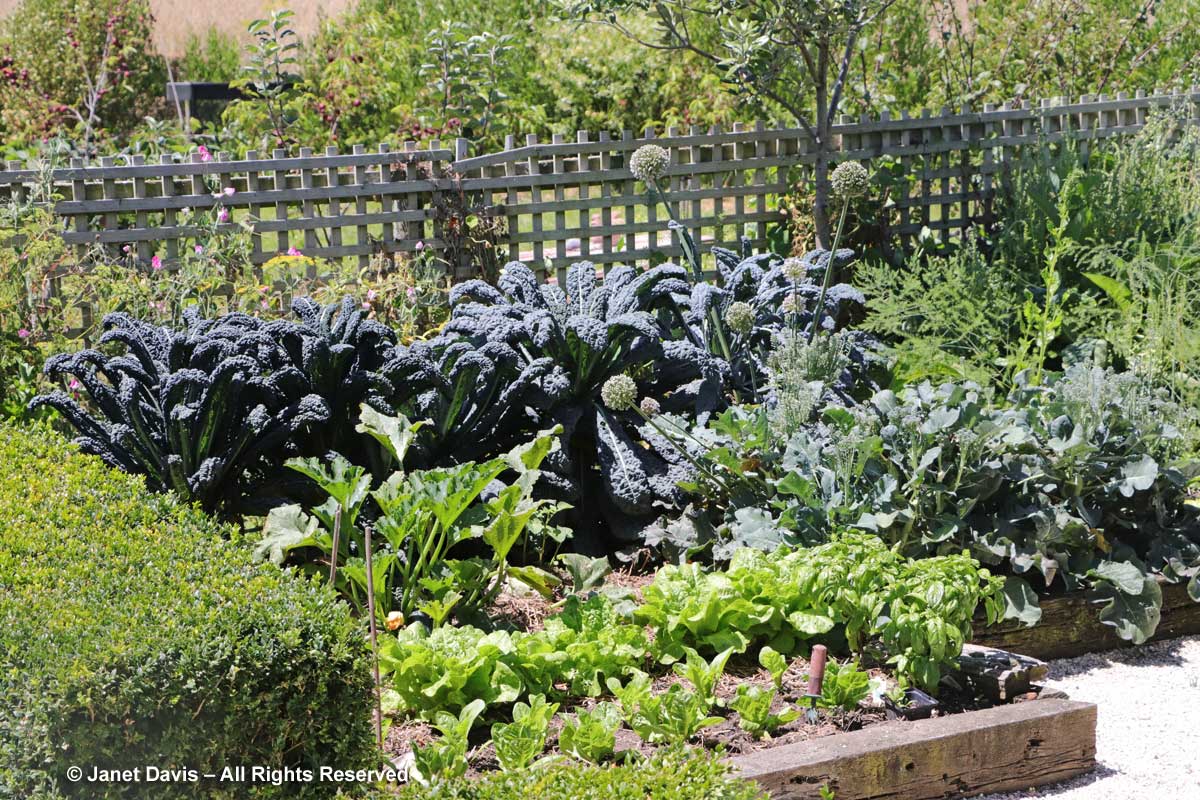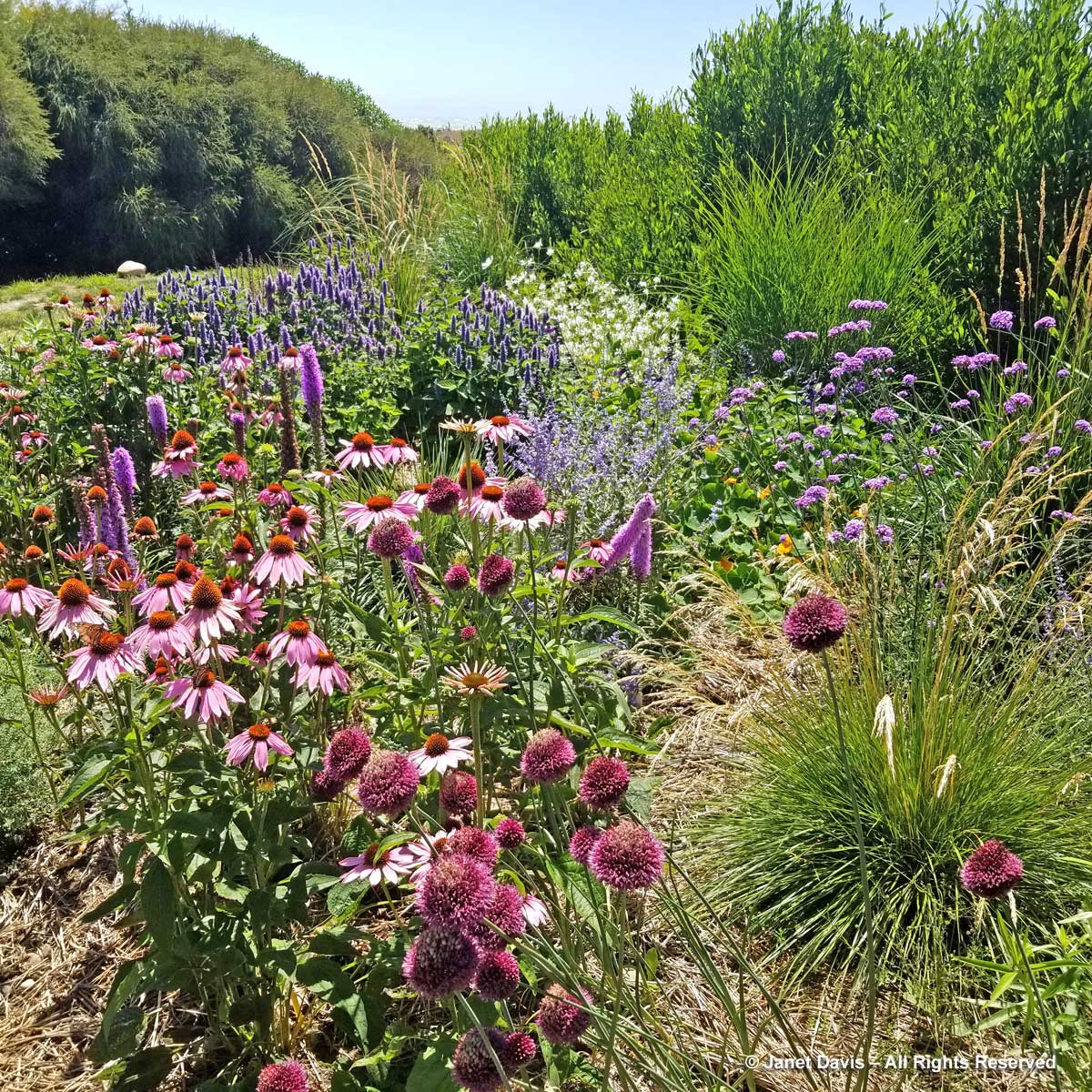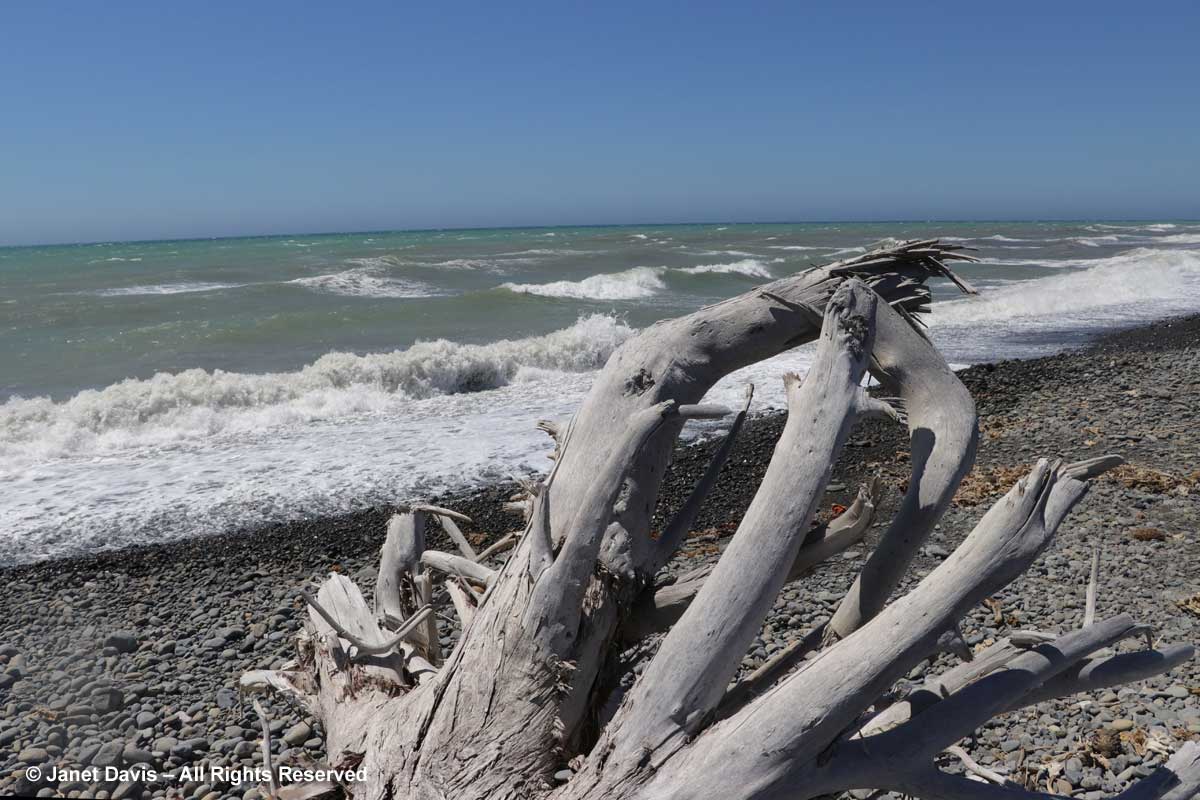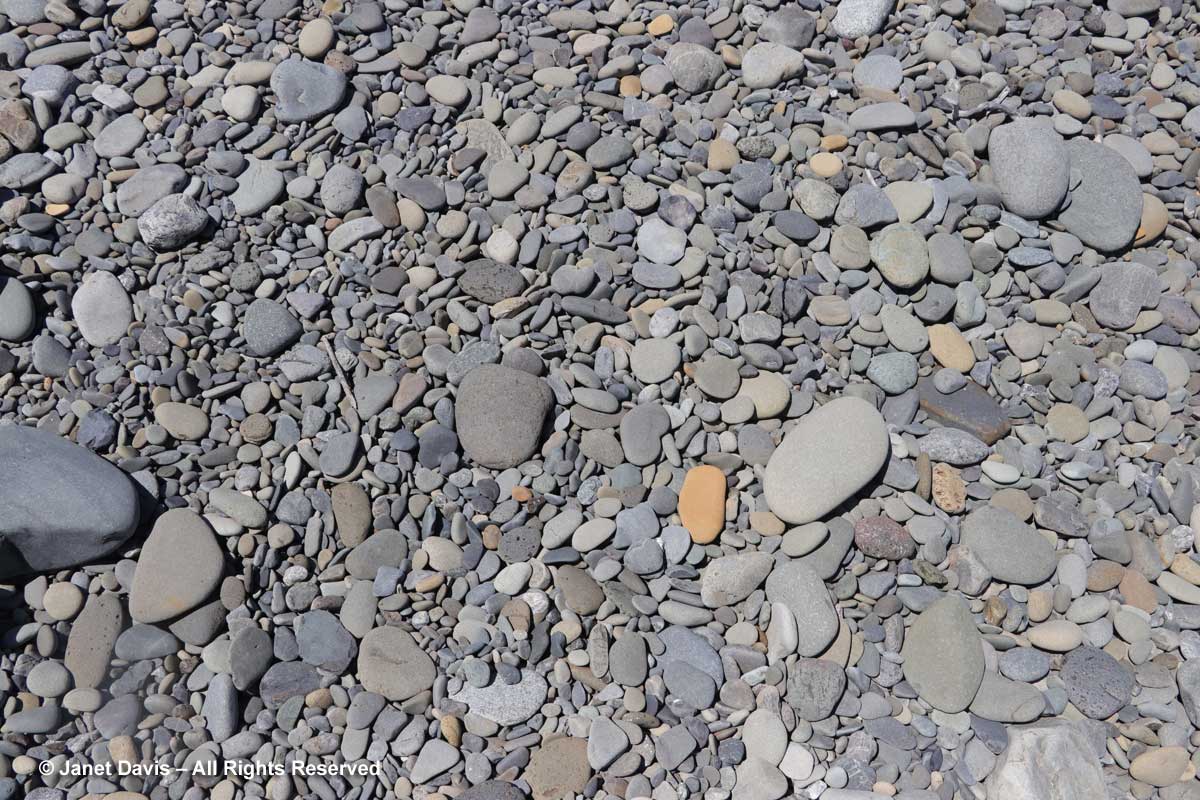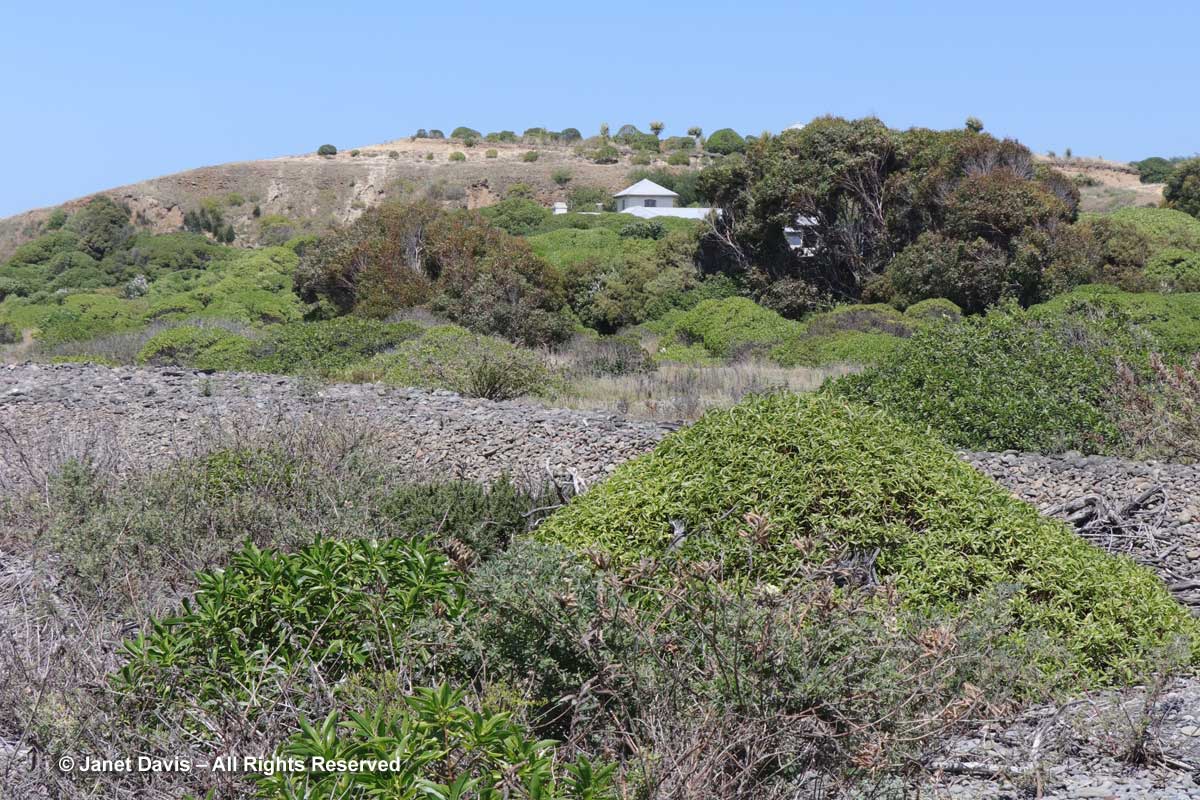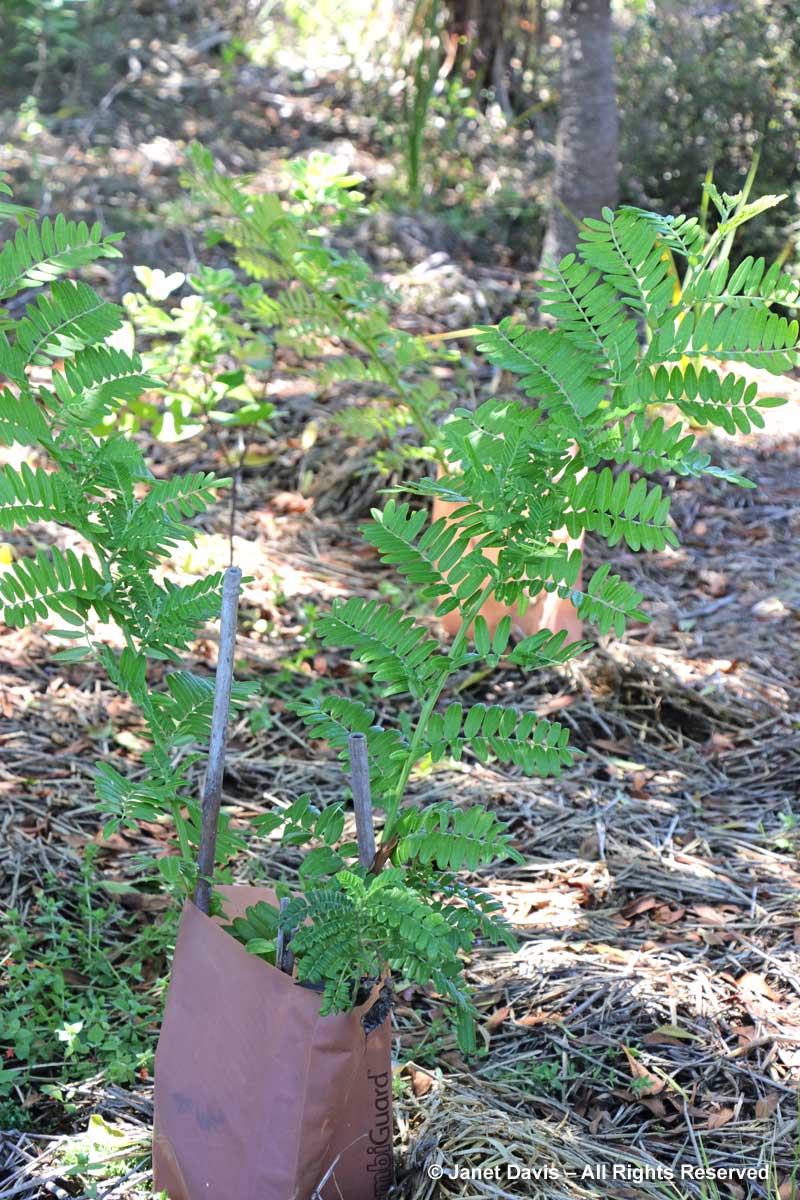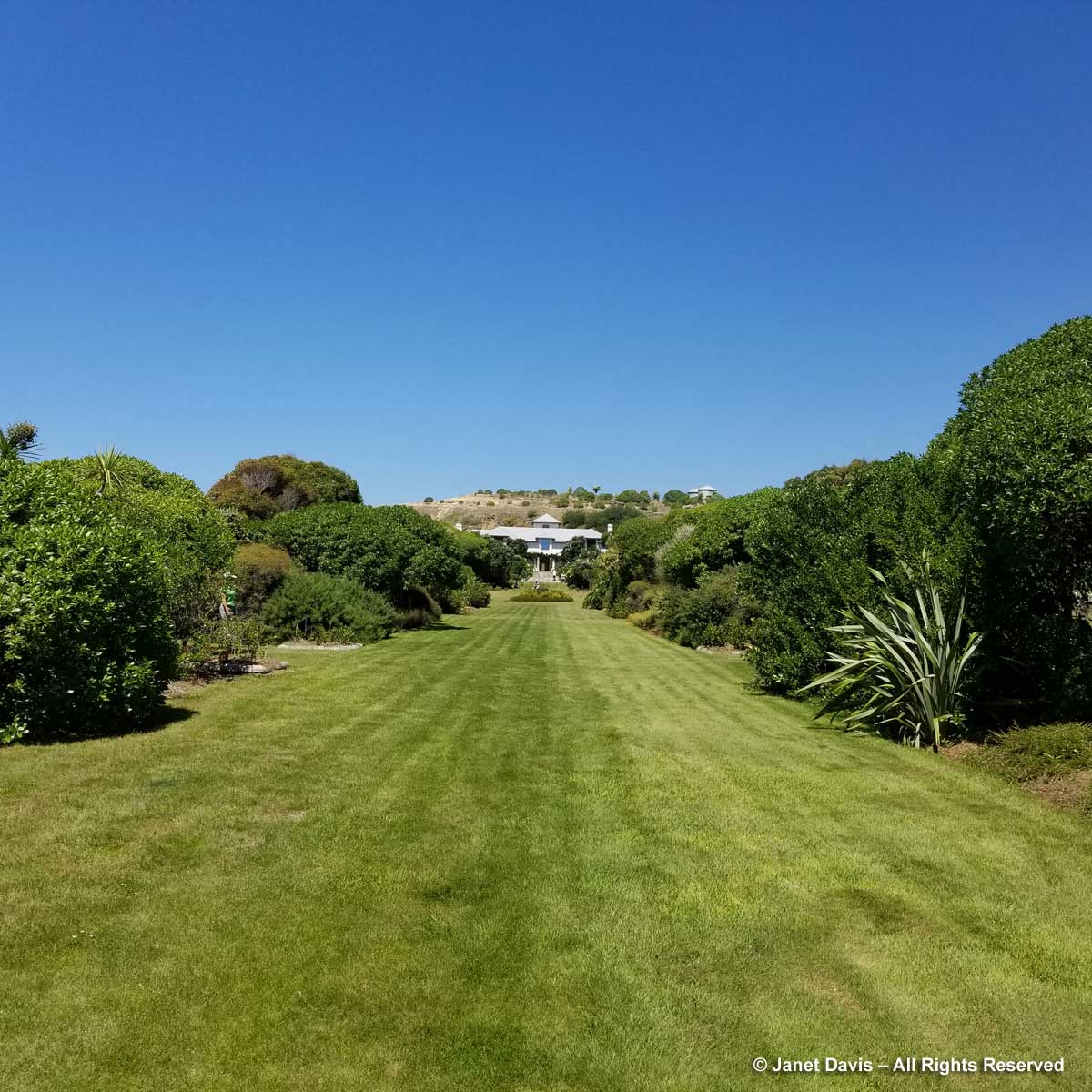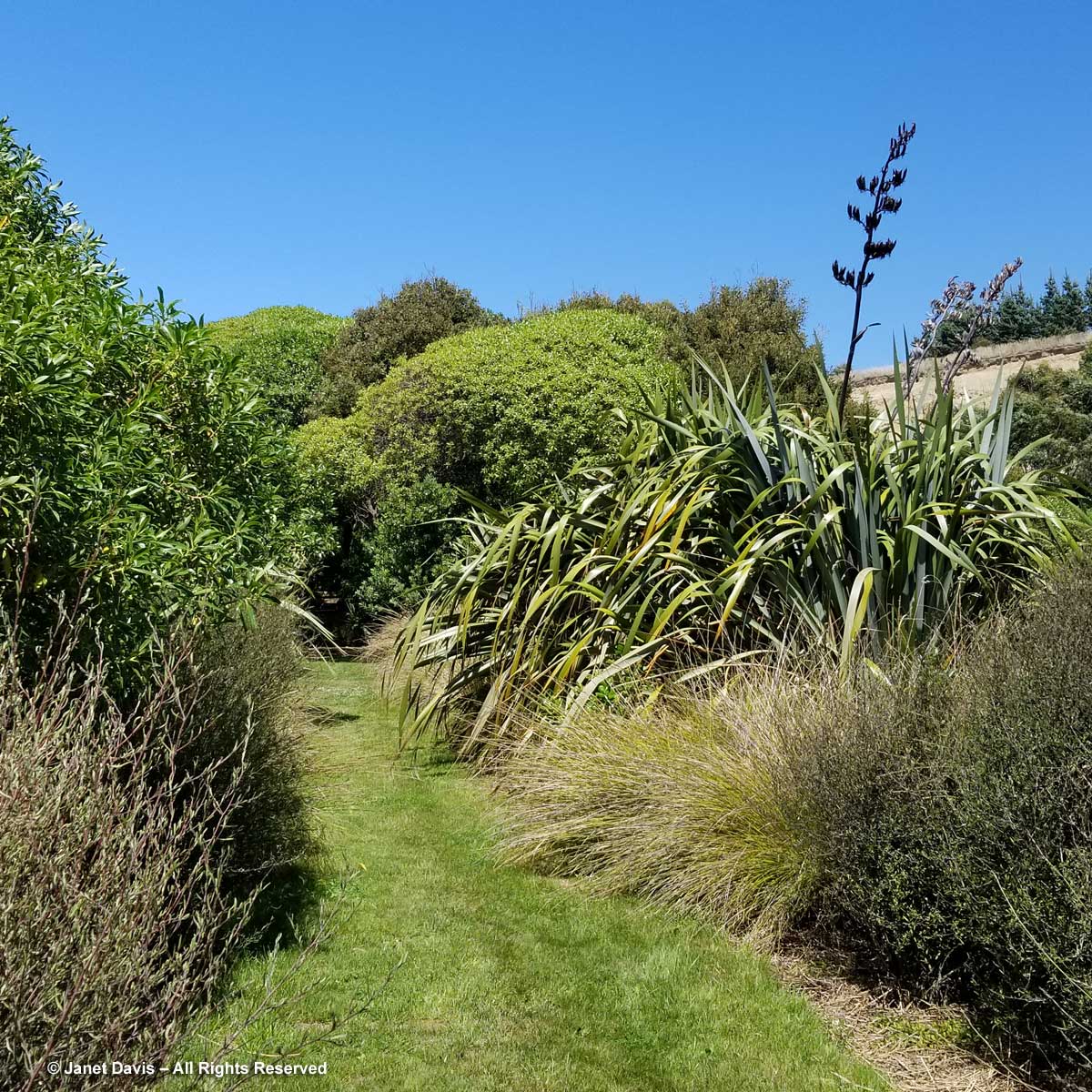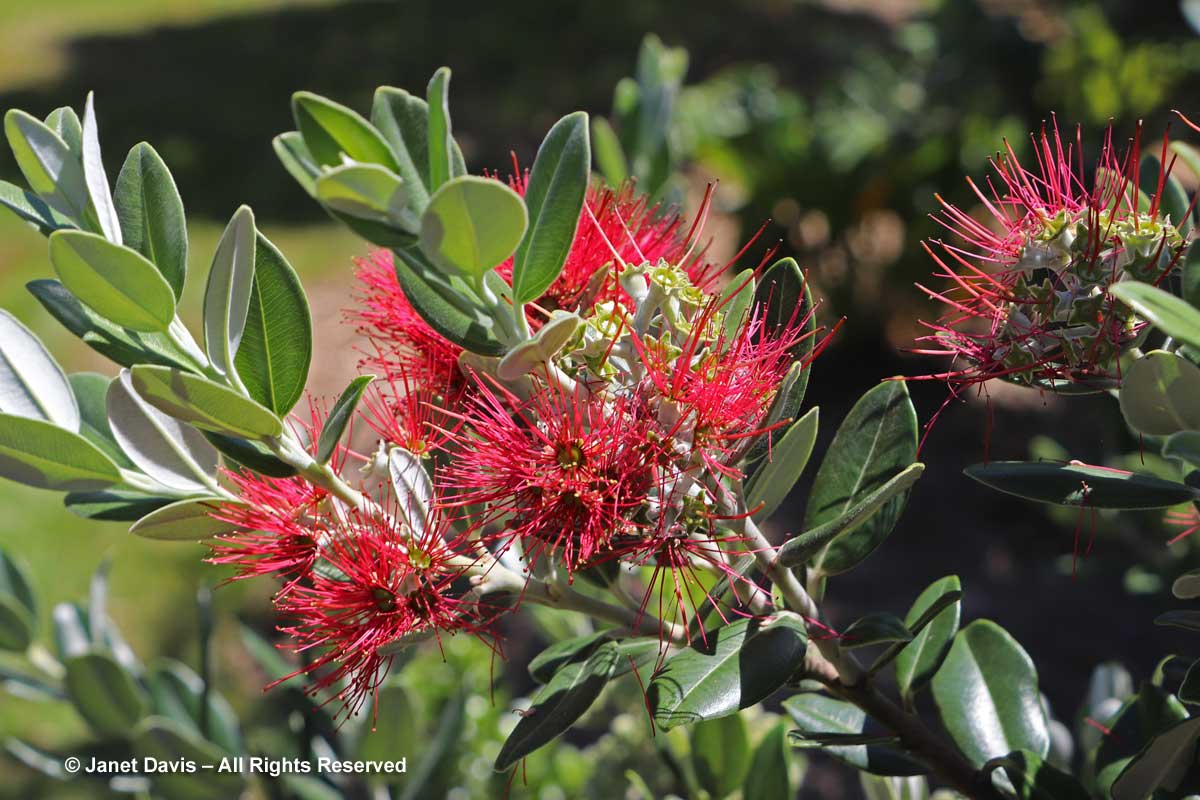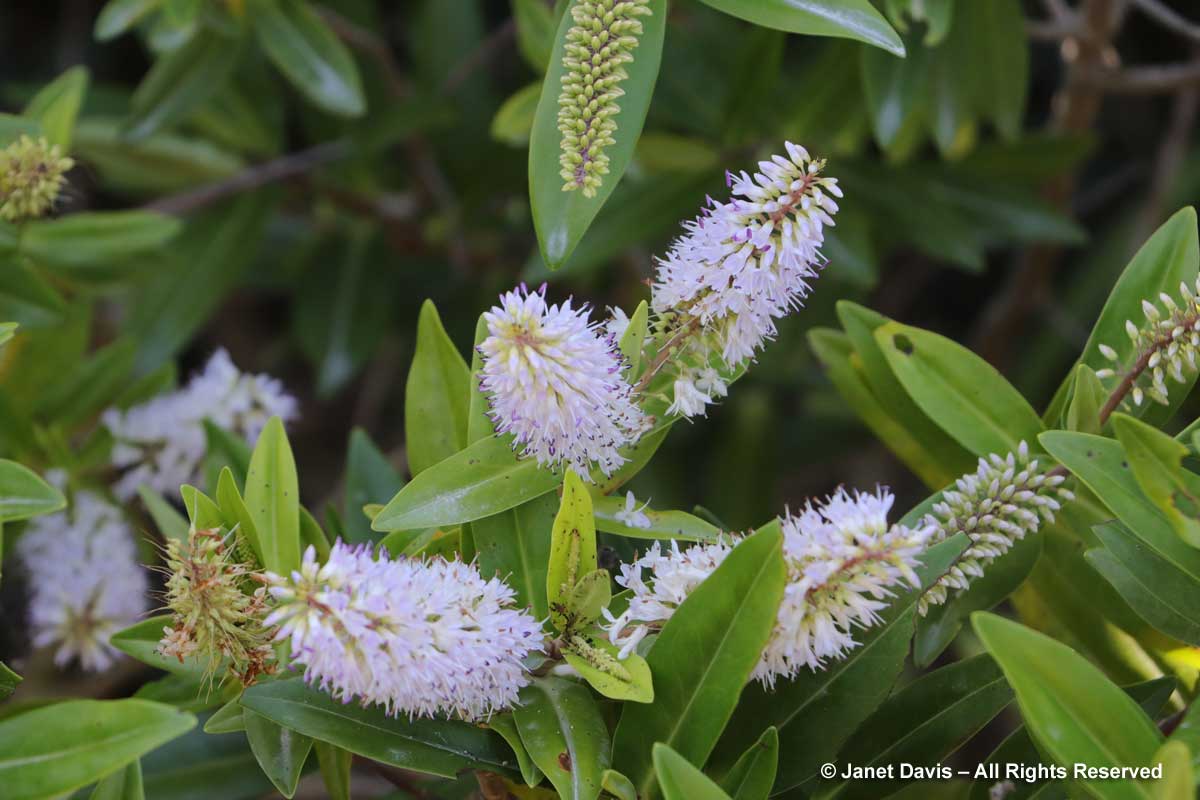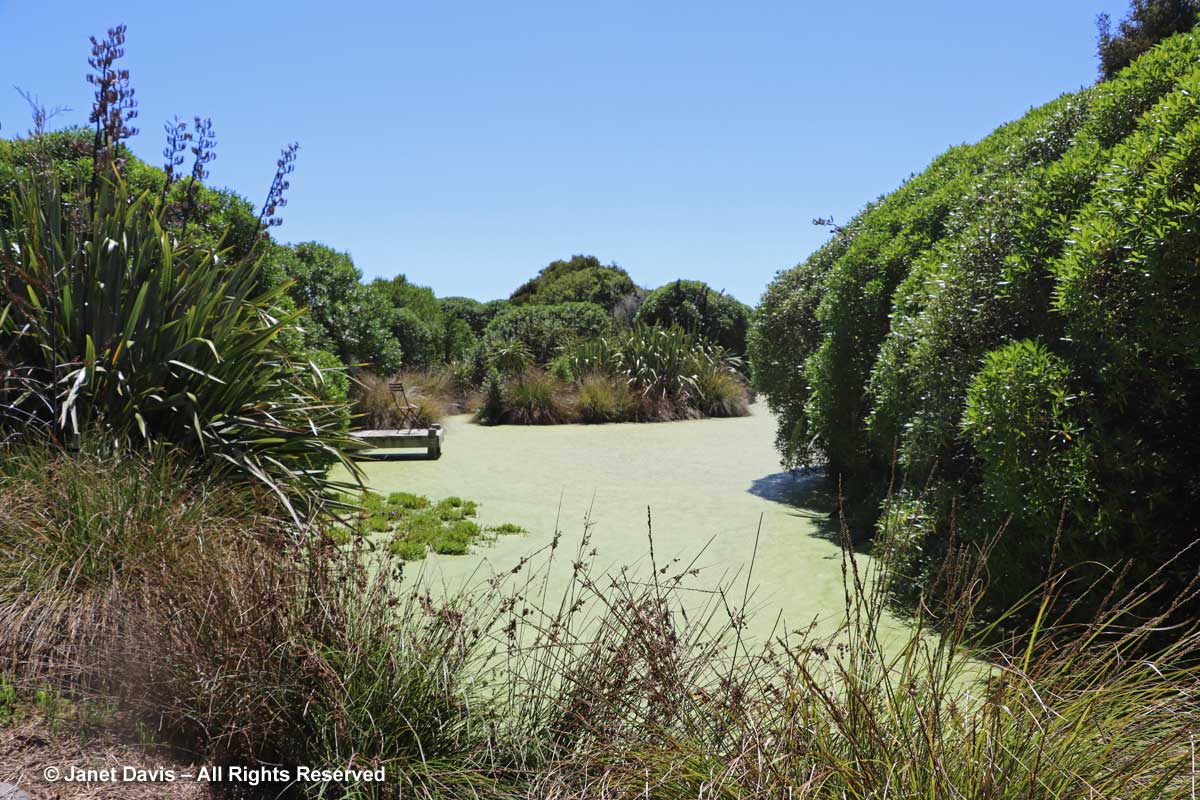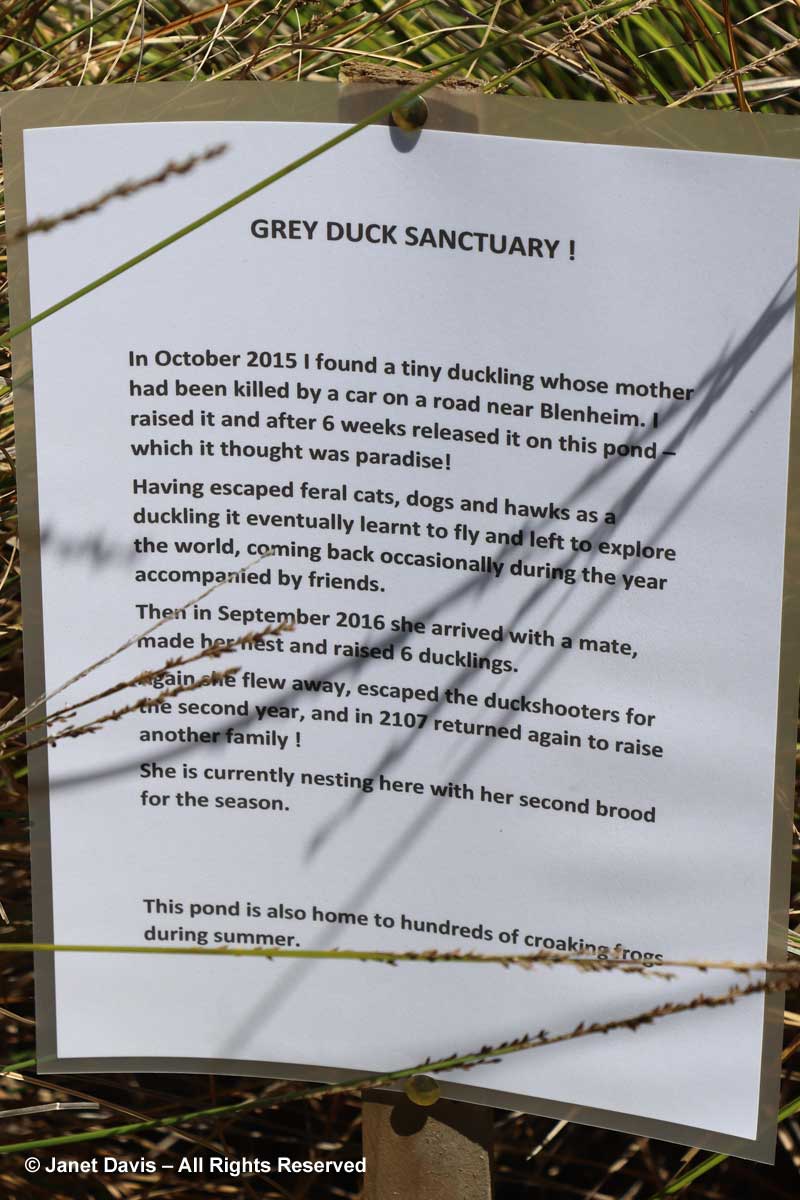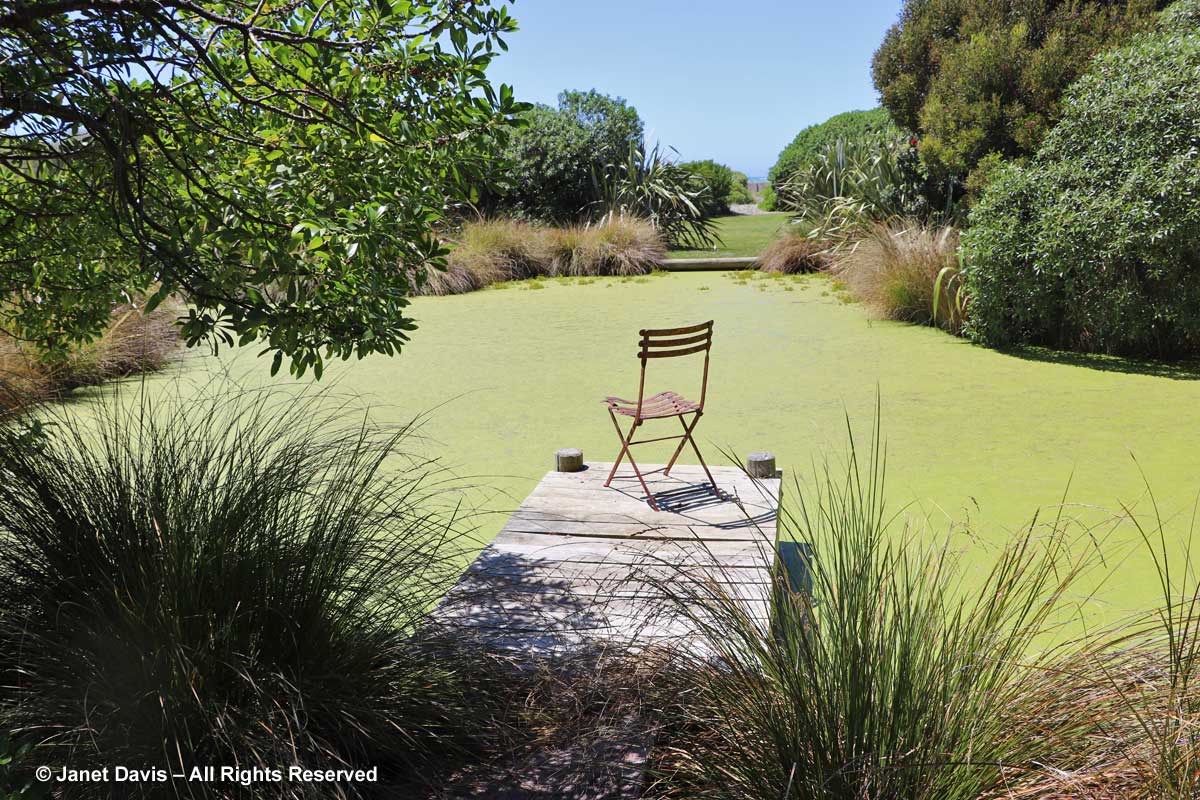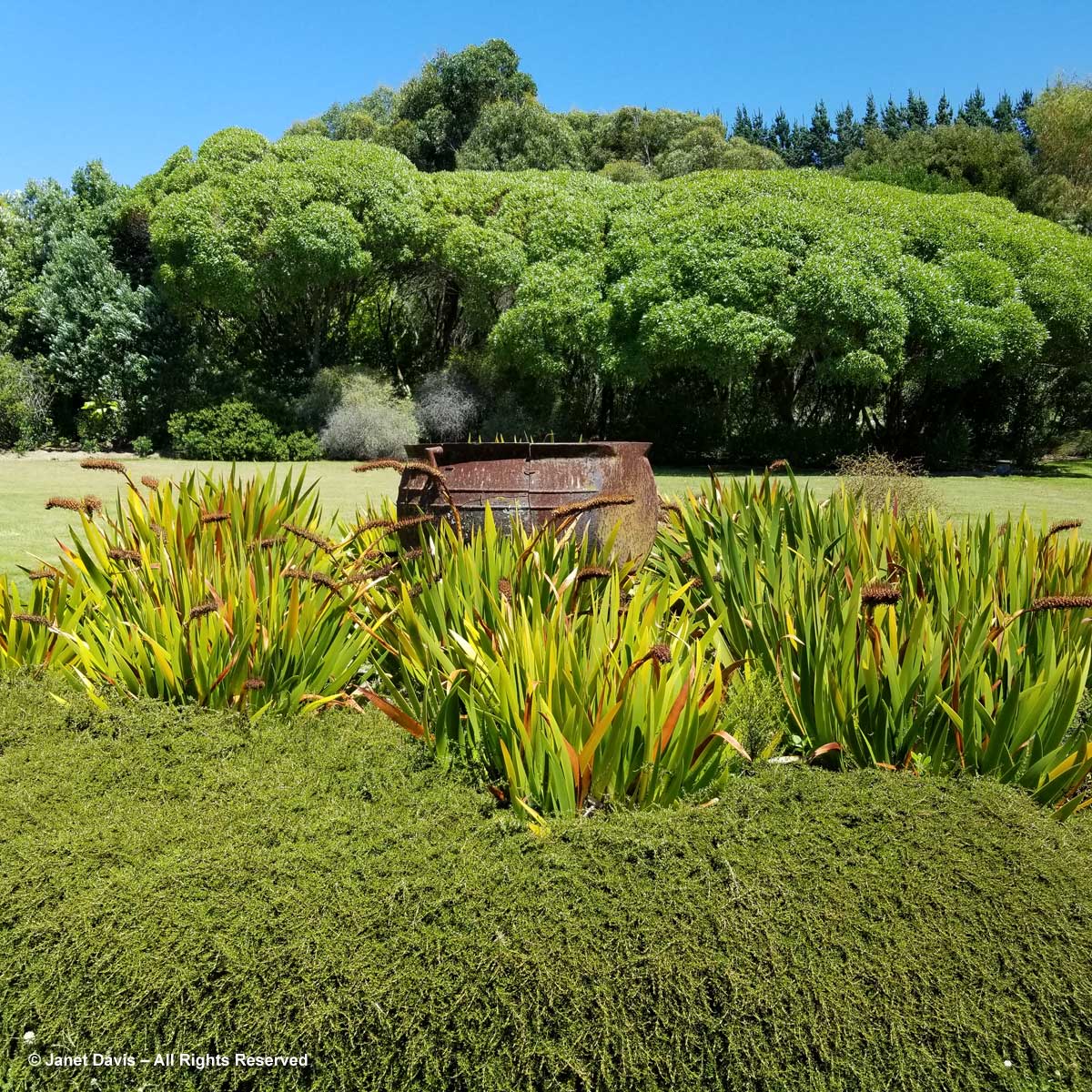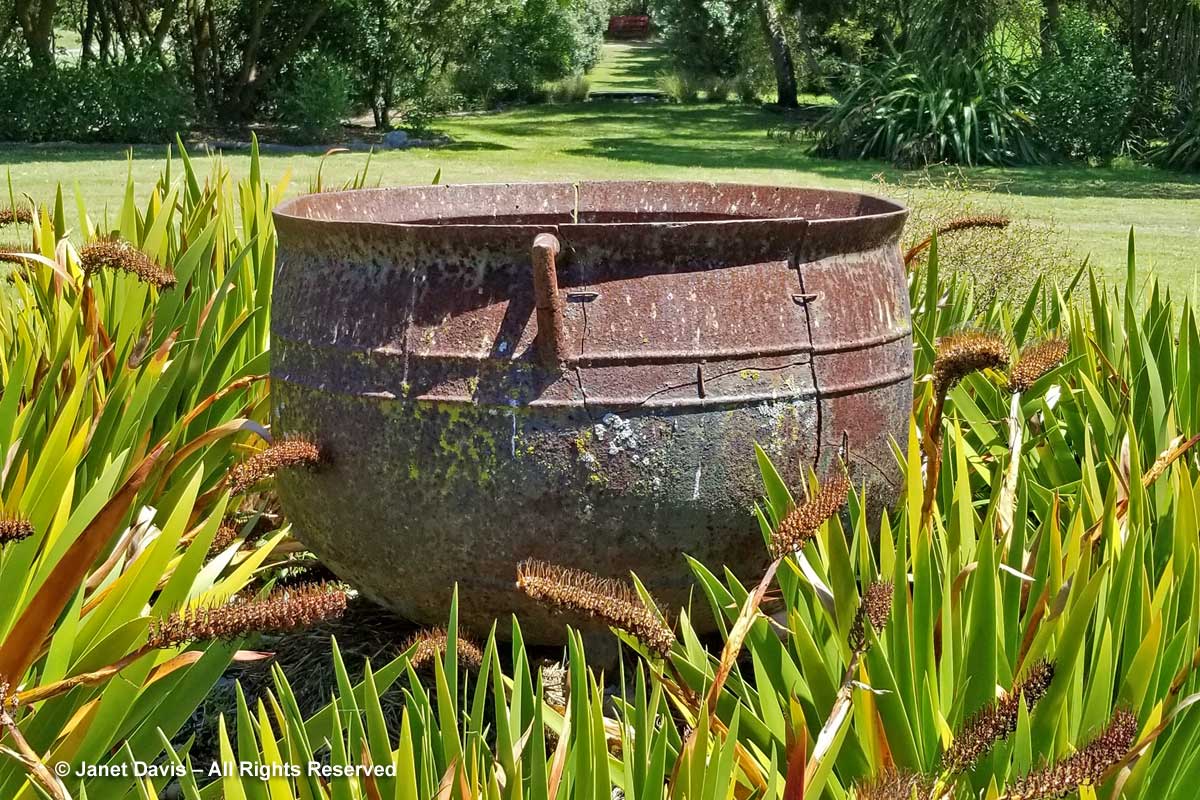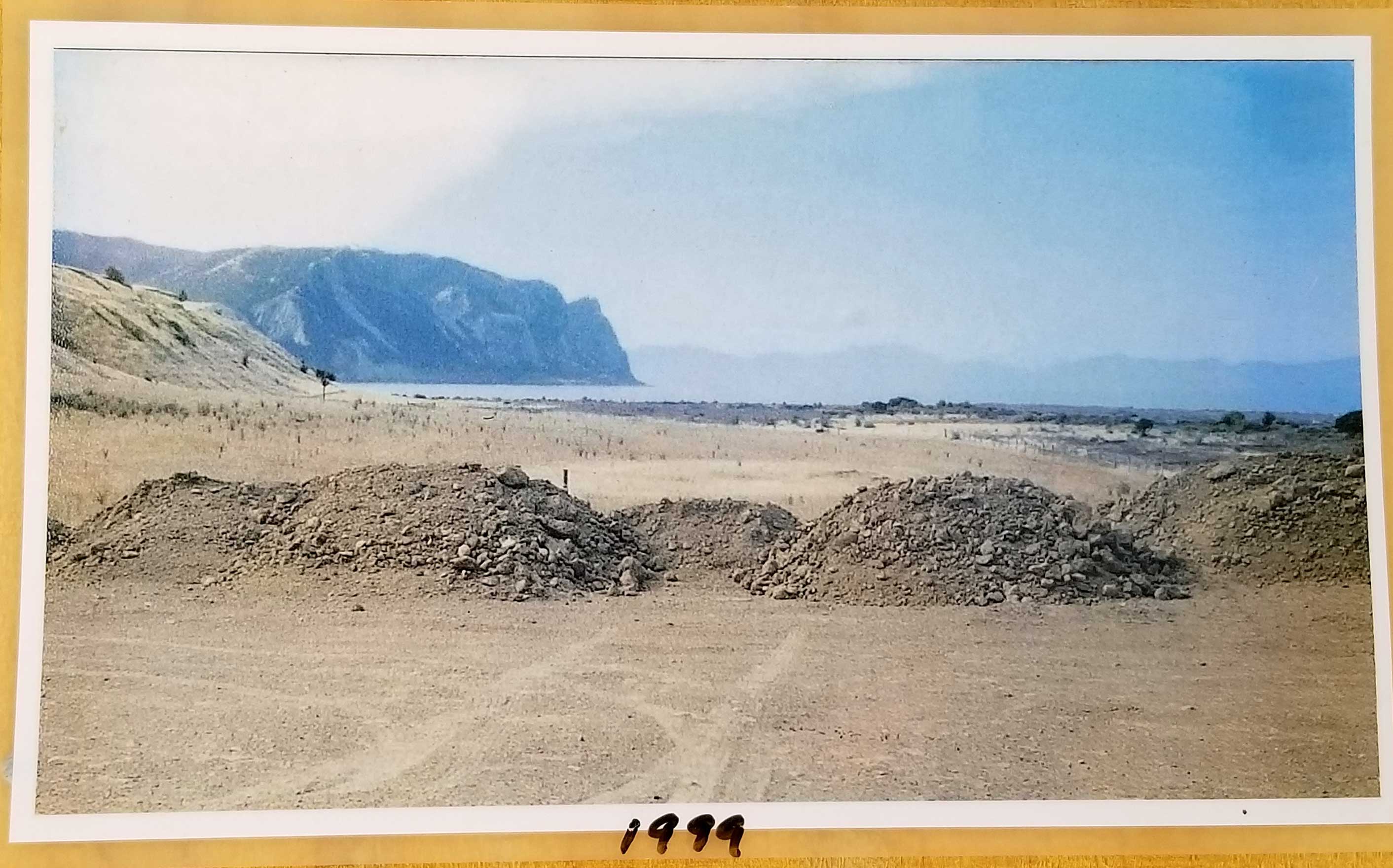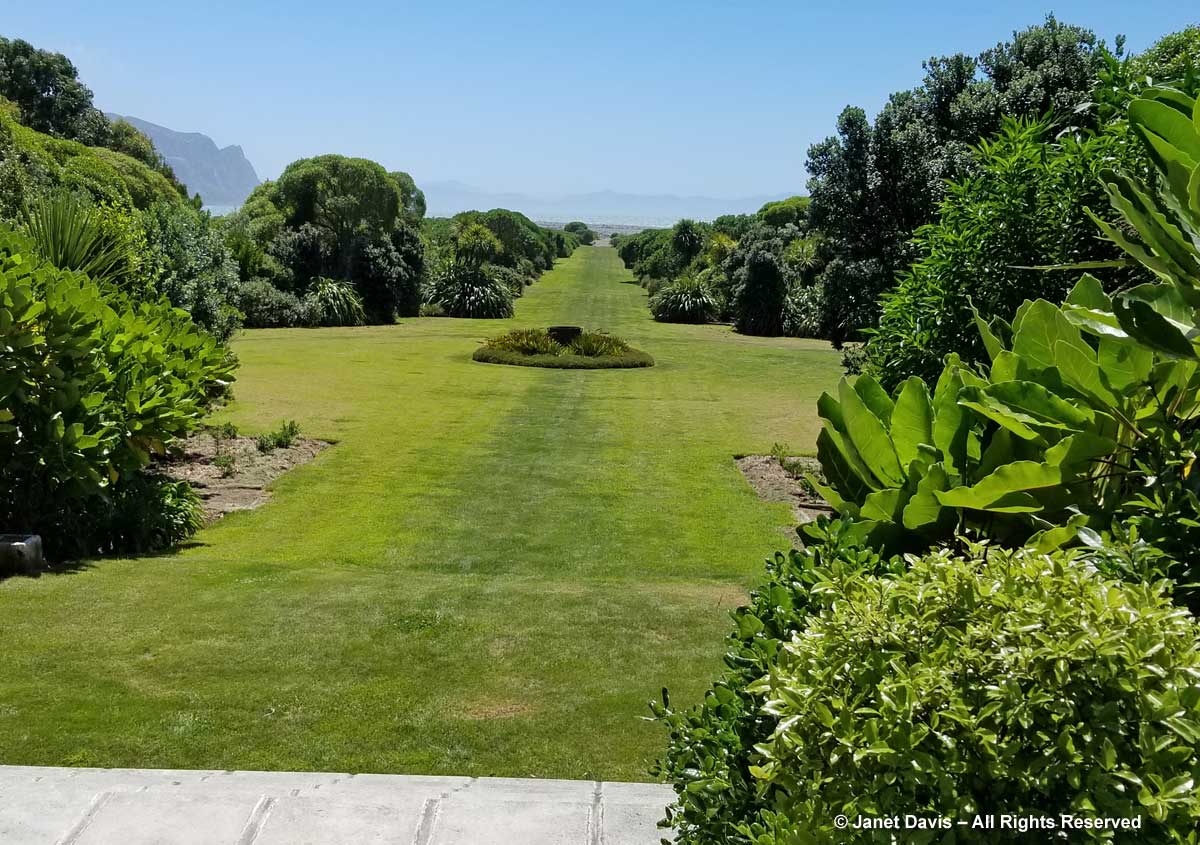Cloudy Bay. If you’re a wine-lover, that name calls up a memory of one of the finest vintages of New Zealand Sauvignon Blanc, a label we all wished we could afford, back in the early 1990s, when the world was discovering the allure of the green-skinned Bordeaux grape that the Kiwis grew and bottled to perfection in the Marlborough Region at the tip of the South Island. We drank our Kim Crawford and Oyster Bay Sauvignon Blancs, yes, but really wished we were sipping a glass of premium Cloudy Bay. So the only disappointment my wine-collecting husband felt in our entire NZ garden tour was at NOT stopping for a tasting at Cloudy Bay Wines on our way through Marlborough. We certainly saw our share of vineyards in the region, en route to and from our stay in the Marlborough Vintners Hotel, some draped with netting to prevent bird damage…..
…… some newly planted…..
…… and some growing in their verdant, geometric patterns up the hillsides.
But Cloudy Bay is also a place on the map, and our destination this morning following our first stop at Barewood Garden was a spectacular property on the shore of the bay that Captain James Cook first named in English in 1770 for the cloudiness of its water, a result of the constant churning of the waves over the stony soil washed into what became known as Cook Strait, between the North and South Islands. Cloudy Bay is now called by its Māori name, Te Koko-o-Kupe/Cloudy Bay, and we were about to visit award-winning Paripuma, a remarkable native plant garden on its shores.
We gathered in a courtyard behind a whitewashed house with simple lines…..
…. and listened to the owner and garden designer, Rosa Davison, talk a little about the property’s history and her own. Having grown up on a farm in the Waihopai Valley in a family that came to the region in the 1840s, she was drawn to the coast near the Marlborough Sounds where she’d spent idyllic childhood vacations. Two decades ago, she and her husband Michael bought the property less than a half-hour south of Blenheim and moved there with three teenagers. Rosa called it Paripuma (Māori for “white cliffs’) for the famous bluffs nearby, and proceeded to plan her garden on barren paddock that ran to the sea.
We walked through the house onto the pergola terrace enclosed in vines….
…..and sheltered from the sun by gauzy, white shade canopies using dowels hooked to slide-wires. I loved this idea.
There were shells that told the story of life at the seashore: spiny murex, ostrich foot shell, starfish and others.
Seen from the bottom of the stairs leading to the garden, there is a simplicity and pleasing geometric balance to the house framed by the enclosing beds of native shrubs and trees, and a lushness to the palette of green and white.
Rosa had set up “before” photos of the property, and they added to the drama of what we were about to see. This celebratory picnic in 1999 (I love the carpet) heralded the beginning of her creative journey….
…and what stretched out before us with Cook Strait in the distance was its spectacular culmination. It was as if André LeNôtre’s little bosquets at Versailles had drifted gently down onto this beachfront property under the Antipodean sun. But here at Paripuma, the formal placement of the gardens flanking the 300-metre (980-foot) central allée fulfills a rigorous ecological imperative: to grow a fairly restricted roster of native shrubs and small trees in order to encourage and sustain native wildlife. And though LeNôtre had gardeners to plant his bosques, Rosa Davison planted everything here herself.
The Google satellite view below shows how the garden’s formal central axis almost parallels the shore of Cook Strait, rather than approaching it on the perpendicular, as I’d imagined it had.
I made the decision to turn right to see some of Rosa’s small, enclosed gardens en route to the beach, so I could later approach the house via the big garden. With a view of the Pacific Ocean in the distance, I walked under tree boughs…..
….. into a formal potager overflowing with leafy vegetables, squash, onions, herbs and berries.
Turning towards the sound of the ocean, I walked through a flower garden filled with familiar perennials – all good pollinator plants in my own meadows and grown here to attract monarch butterflies, which arrived naturally in New Zealand in the 1870s and are thus considered native.
Before long, I was standing at the water’s edge, gazing towards those cliffs that inspired the garden’s name, and the crashing waves that inspired Captain Cook to call it Cloudy Bay. That’s all still South Island in the distance, with the Tasman Sea out of sight behind.
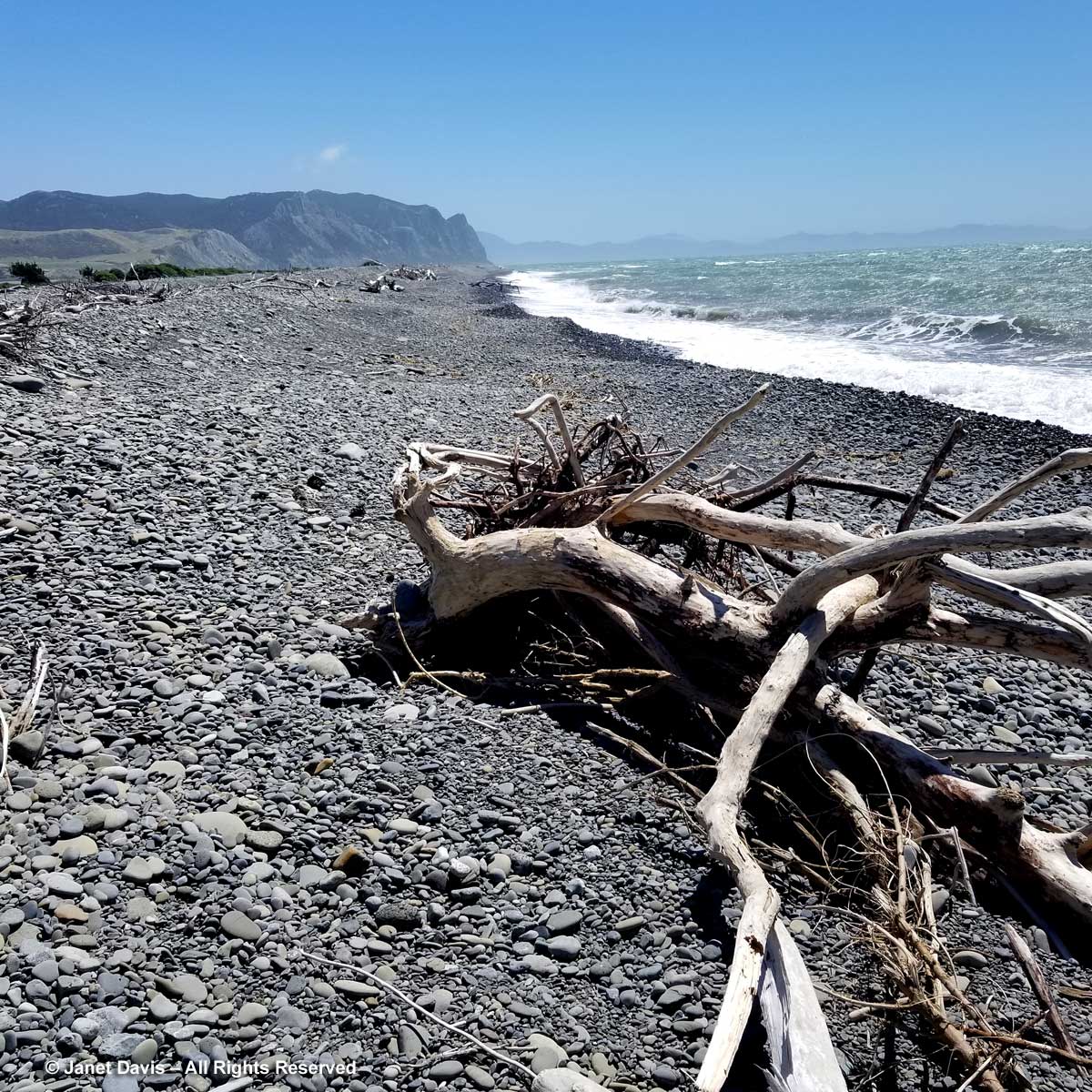
But gazing the other way, I looked straight out toward the Pacific Ocean.
Looking down at my feet, I saw the smooth, wave-tumbled rocks that give a “shingle beach” its name. Shingles can range from fairly large cobbles to small stones, and are usually a mélange of different types of rocks.
As I looked back over the shore plants towards the house, it was difficult to imagine how barren this was just two decades ago.
Rosa is also planting natives between the garden and the shore, like this young kākābeak (Clianthus puniceus). And though she welcomes all animals into the garden, including rabbits, young plants are protected with sleeves to give them a fair head start.
Then it was time to explore the main garden.
Mown paths guide visitors between the various beds and invite close inspection of the natives, like the tall harakeke or New Zealand flax (Phormium tenax) and carex species.
A few New Zealand Christmas trees or pōhutukawa (Metrosideros excelsa) were still in flower.
And of course there was native hebe or koromiko (H. salicifolia), among many other plants in the various beds, including ngaio (Myoporum laetum), ake ake (Dodonaea viscosa), puka (Meryta sinclairii), coprosmas, cabbage trees or tī kōuka (Cordyline australis), Nikau palms (Rhopalostylis sapida) and wire vine (Muehlenbeckia sp.) She also grows the extremely rare, critically endangered Three Kings Kaikomako (Pennantia baylisiana), which I was able to see the next day at Otari-Wilton’s Bush Native Garden in Wellington.
I came to a small pond surrounded by plants…..
….. with a charming sign that describes its seasonal habitation by one of the many wildlife species that have made Rosa’s garden their own. With all the frogs in the pond, I can only imagine the night music at Paripuma.
Circling the pond, I came to the perfect little dock with one perfect little chair – and only wished we had more time so I could sit here for a moment to take it all in. Notice the view lines right across the central allée to the far side.
Wandering back toward the central path, I took a closer look at the big garden’s simple focal point, set in a small bed of poor knight’s lily (Xeronema callistemon) that had already flowered.
It is an antique whale pot once used at nearby Port Underwood for rendering down whale oil during New Zealand’s notorious whaling era. When the pots were in active use, mostly in the 19th century (including American and Australian whalers), the nation saw its native whales – especially southern rights, humpbacks, sperms – hunted to near decimation. In the years 1911-1964, not far from Paripuma on a headland in the Marlborough Sounds that flows into Cook Strait, 4200 whales were caught at one shore station alone, including the last whale ever killed in the country. Since 1978, whales in New Zealand’s 200-mile offshore waters have been protected under the Marine Mammals Protection Act. As a wildlife-lover and conservationist who supports the New Zealand Whale and Dolphin Trust, Rosa Davison’s whale pot is an evocative and stark reminder of those days, and of the threat that international whaling continues to pose to the country’s whales outside its protective waters.
I headed back up the stairs to the house, taking another look at a photo of Paripuma before the garden was made.
And then I gazed out over this truly amazing landscape once more. New Zealand’s Gardens Trust has named Paripuma a 5-star Garden of National Significance, but it is more than that. It is one woman’s vision fully realized: planned, designed, planted and opened for visitors to explore, and enjoy.
***********
Planning a trip to New Zealand? There could be no better way to enjoy the scenery and wines of Marlborough than to return ‘home’ each night to one of the region’s most beautiful gardens. Paripuma is available to rent as a bed-and-breakfast, with varying rates based on the accommodation chosen. If we ever get back to Cloudy Bay to taste our favourite Sauvignon Blanc, staying here would be the first order of business.

